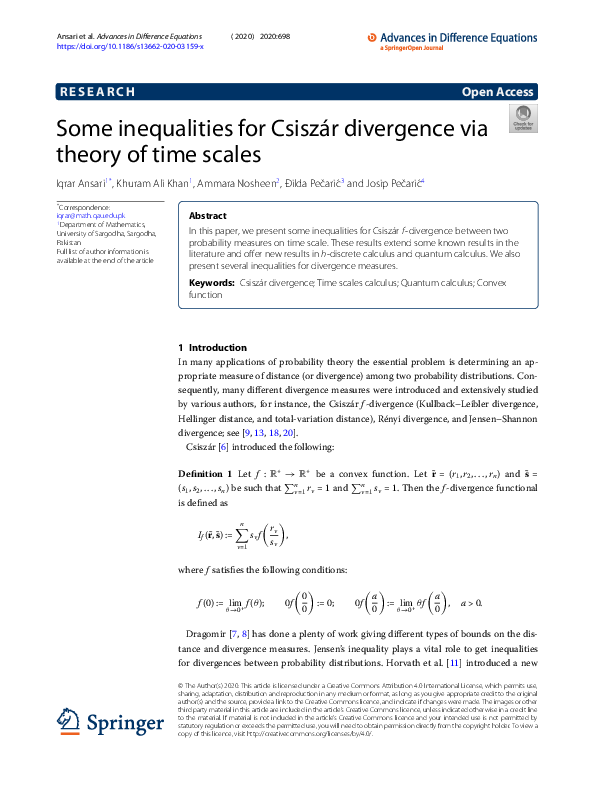Academia.edu no longer supports Internet Explorer.
To browse Academia.edu and the wider internet faster and more securely, please take a few seconds to upgrade your browser.
Some inequalities for Csiszár divergence via theory of time scales
Some inequalities for Csiszár divergence via theory of time scales
2020, Advances in Difference Equations
In this paper, we present some inequalities for Csiszárf-divergence between two probability measures on time scale. These results extend some known results in the literature and offer new results inh-discrete calculus and quantum calculus. We also present several inequalities for divergence measures.
Related Papers
Journal of Inequalities and Applications
Estimation of divergence measures via weighted Jensen inequality on time scalesThe main purpose of the presented paper is to obtain some time scale inequalities for different divergences and distances by using weighted time scales Jensen’s inequality. These results offer new inequalities in h-discrete calculus and quantum calculus and extend some known results in the literature. The lower bounds of some divergence measures are also presented. Moreover, the obtained discrete results are given in the light of the Zipf–Mandelbrot law and the Zipf law.
2021 •
Taylor’s polynomial and Green’s function are used to obtain new generalizations of an inequality for higher order convex functions containing Csiszár divergence on time scales. Various new inequalities for some divergence measures in quantum calculus and h -discrete calculus are also established.
Advances in Difference Equations
Estimation of divergences on time scales via the Green function and Fink’s identity2021 •
The aim of the present paper is to obtain new generalizations of an inequality for n -convex functions involving Csiszár divergence on time scales using the Green function along with Fink’s identity. Some new results in h -discrete calculus and quantum calculus are also presented. Moreover, inequalities for some divergence measures are also deduced.
2009 •
In this paper our underlying motivation is to estimate the dif- ference between the two sides of the relevant f-divergence and Shannon's in- equality. In this paper we will give the bounds and also we will give some improvements of f-divergence and Shannon's inequality
Computers & Mathematics with Applications
On some -analogues of integral inequalities on discrete time scales2011 •
Abstract and Applied Analysis
Integral Inequalities on Time Scales via the Theory of Isotonic Linear Functionals2011 •
RELATED PAPERS
LA BIBLIOTECA DEL EDIFICIO SABATINI DE LA FÁBRICA DE ARMAS DE TOLEDO
LA BIBLIOTECA DEL EDIFICIO SABATINI DE LA FÁBRICA DE ARMAS DE TOLEDO2021 •
Xpress Publishing An Imprint of Notion Press India. Singapore. Malaysia.
Recent Advance in Educational Pedagogies2024 •
Monumenta Archaeologica Barbarica, Series Gemina, Tomus V Lębork-Warszawa 2015, pp. 43-68.
EARLY MEDIEVAL CEMETERY AT CZARNÓWKO // WCZESNOŚREDNIOWIECZNE CMENTARZYSKO W CZARNÓWKU2015 •
Physical Chemistry Chemical Physics
Simultaneous Neutron Powder Diffraction and Microwave Characterisation at Elevated Temperatures2021 •
HAL (Le Centre pour la Communication Scientifique Directe)
Smile Please" by Jean Rhys: the originality of the original text or the childhood narrative in question2021 •
INCT-APA Annual Activity Report
Insecticidal effects of antarctic algae Prasiola crispa extract in the adult fruit fly Drosophila melanogaster2010 •
Córima, Revista de Investigación en Gestión Cultural
Tendencias, retos y tensiones globales de la gestión cultural y su formación. Entrevista a Lluís Bonet Agustí2018 •
Ecotoxicology and Environmental Safety
Dose-related impacts of imidacloprid oral intoxication on brain and liver of rock pigeon (Columba livia domestica), residues analysis in different organs2019 •
International journal of advanced trends in computer science and engineering
A Mobile Application Based Optimized Out-Patient Emergency Request Model2024 •
International Journal of Clinical Practice
Experience in implementation of cardiovascular absolute risk assessment and management in Australian general practice2010 •
2024 •
2020 •
RELATED TOPICS
- Find new research papers in:
- Physics
- Chemistry
- Biology
- Health Sciences
- Ecology
- Earth Sciences
- Cognitive Science
- Mathematics
- Computer Science

 Gilda Pecaric
Gilda Pecaric